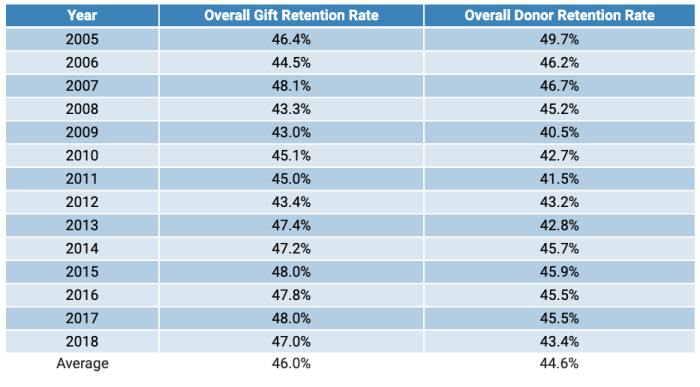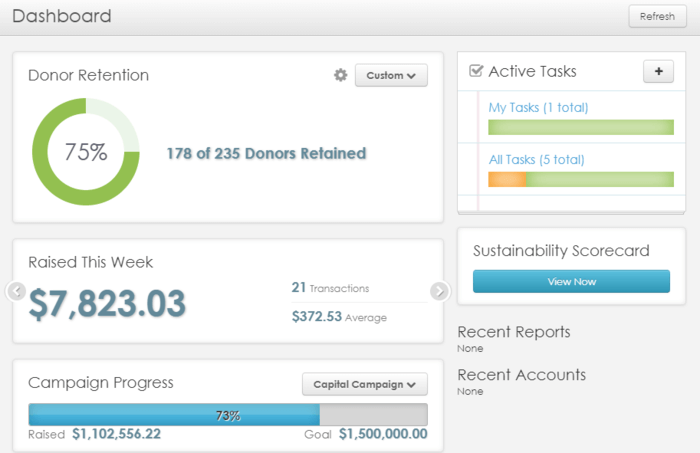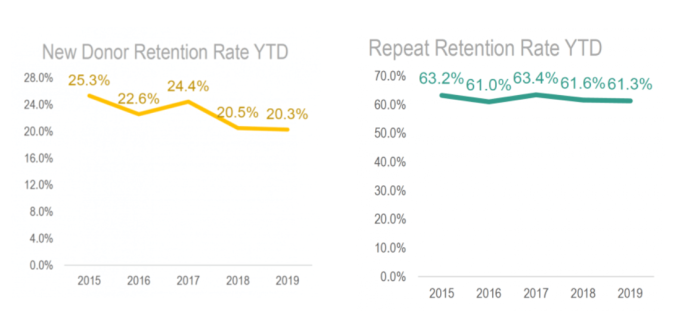
By Jay Love
Nonprofit professionals have a lot on their minds. You’re probably thinking about methods to keep your staff and constituents safe during the pandemic, effective work-from-home strategies to keep everyone productive, and how to maintain programming while adhering to social distancing guidelines.
Whatever you do, don’t stop fundraising during these difficult times. While this fundraising may look different, it should never cease entirely. You need revenue to keep your organization alive amidst a shifting economy.
Not only that, but it’s imperative that you analyze your fundraising strategy and consider additional strategies you can take to ensure that when all of this has subsided, your organization comes out on top.
This means one of your organization’s main priorities right now should be maintaining and improving your donor retention rate.
According to Bloomerang’s donor retention guide, the average donor retention rate has been sitting between 40% and 50% for the last fifteen years. The image below shows its progression.
 Your nonprofit should aim to be above average in your donor retention now so when the pandemic ends, you’ll have developed these relationships and have an even stronger base of support.
Your nonprofit should aim to be above average in your donor retention now so when the pandemic ends, you’ll have developed these relationships and have an even stronger base of support.
A higher donor retention rate translates directly to higher revenue for a few reasons. First, retaining donors is substantially less expensive than acquiring new donors. Second, donor gifts tend to increase as they develop stronger connections with your mission. Finally, donor retention leads to a more predictable revenue stream, putting it in a good position to increase steadily.
In order to increase your nonprofit’s donor retention rate and secure additional funding, even during difficult times, we recommend the following strategies:
- Make donor retention a priority.
- Create strong first impressions.
- Focus on engagement.
- Stay transparent with supporters.
Here at Bloomerang, we’ve helped nonprofits just like yours increase their fundraising revenue by focusing their attention on donor retention. These strategies can help you too! Let’s get started.

1. Make donor retention a priority.
In order to effectively improve your organization’s donor retention, you must make it a priority. You simply can’t wish that it will improve, barely adjust your approach, and then expect your rates to drastically increase. Rather, you should recognize that the work you put into developing your donor retention strategies is directly correlated to the results you’ll see in your fundraising revenue.
One of the best ways to make sure you’re making donor retention a priority is to put donor retention information front-and-center for you and your staff to see.
To do this, you may consider the following placements:
- On the fundraising dashboard in your CRM. The best option is to choose a CRM (Customer Relationship Management) solution that emphasizes donor retention and its importance for your organization. This will automatically track your retention rate for your team to see. Plus, effective engagement and donation tracking within donor profiles will help drive your retention rates up. This guide can help you choose a solution that prioritizes your donor retention rates.

- In regular communication documents with your team. If your team hosts regular organization-wide check-in meetings, create a standing slide in your presentation tool to update them about the current progress and status of your donor retention rate.
- On your office’s wall. When your team is back in the office, consider tracking your progress with a “donor retention meter” posted in a common space. This meter should show your current donor retention rate, your goal rate, and the trend line that measures your progress so far.
If your organization sets quarterly or annual goals, consider incorporating donor retention into these goals. This will make sure your whole team is on the same page and working toward improving these metrics.

2. Create strong first impressions.
Donor retention is all about strengthening your relationships with supporters. The beginning of that relationship is crucial for achieving your retention goals. After all, the majority of donors donate once and then never again.
According to reports from the Fundraising Effectiveness Project, the average new donor retention rate is very low (around 20%) while repeat donor retention rates jump drastically (to over 60%). This means if your nonprofit can convince people to donate a second time, chances are they’ll keep giving in the future. That’s why the second donation is often referred to as the golden donation.
 To make sure your nonprofit begins relationships with supporters on the right foot, we recommend you consider the following strategies:
To make sure your nonprofit begins relationships with supporters on the right foot, we recommend you consider the following strategies:
- Streamline the donation process. Donation abandonment occurs when you’re able to get people to your donation page, but they never hit “submit” on the donation itself. This can occur when your donation process is not optimized. We recommend strategically organizing your donation page so the process is quick and easy for supporters to complete. You can do this by only asking for the information you need, ensuring everything fits on one page, and including a clear “submit” button.
- Send immediate appreciation. In addition to including a confirmation page after the donation is submitted, be sure your organization is following up immediately after every donation by sending a thank-you note. This will further confirm that you received the donation and show your donor that you’re grateful for their contribution. Consider sending new supporters a welcome packet or other information to greet them after their initial gift.
- Call your new supporters. Calling new supporters personally shows them your organization cares deeply and wants to start a relationship. It’s a more personal way to thank them. In fact, our own research shows that calling donors at least once within 90 days of their first donation increases first-time donor retention by over 20%.

As you can see, increasing the first-time donor retention rate is an effective first step to take in increasing your overall donor retention. You’re lucky to have such incredible supporters for your cause. Show them that gratitude and kick off your relationships right!

3. Focus on engagement.
Nonprofits have a bad habit of treating their donors like ATMs. When you need funding for something, your donors are there to support you. Well, that’s not quite right. Your donors are happy to help support your organization when they feel engaged and connected to your cause.
Therefore, it’s important that nonprofits focus their attention on enhancing the engagement of and experience given to your donors. After all, they’ve already given to your cause, signaling that they want to be involved.
Focus on engaging your supporters by:
- Showing them they’re partners in your mission. Give your supporters an opportunity to provide input on your organization’s activities through feedback and potential (virtual) meetings. This is especially important for your major donors. It shows them they’re true partners. After all, without their generous contributions, your philanthropic activities wouldn’t be possible.
- Tracking supporter engagement activities. Keeping track of supporters’ engagement can help your organization see when donors are in danger of lapsing so you can prevent that from happening. It also shows the types of activities your supporters are interested in so you can personalize outreach for further involvement. For example, if a donor has attended all of your events throughout the last year, you might send a personalized invitation to your next one because you know they enjoy that type of activity.
- Communicating with them frequently. Frequent communication is the key to staying at the forefront of your donors’ minds. Make sure to strike the perfect balance between contacting them frequently and not overloading their inboxes. Every communication you send should include helpful information so you’re not just sending messages solely for the sake of staying in contact.
If you’re not sure how to incorporate additional engagement activities into your fundraising strategy, a nonprofit consultant may be able to help you refine your strategy. To find a consultant who is a good fit with your nonprofit, check out listings of top firms from trusted organizations. For instance, you may reference Bloomerang’s consultant directory or Aly Sterling Philanthropy’s list of top consultants.

4. Stay transparent with supporters.
Your supporters appreciate transparency. Not only do they want to know your organization is using their contributions wisely, they also want to help truly further your mission about which you and your supporters are both passionate.
This means you should be transparent with your supporters about the successful strategies you try as well as those that aren’t successful. When you run into troubles or setbacks, communicate these, but be sure to also provide context. For instance, if you have a negative return on a fundraising campaign, explain what went wrong and how you’ll remedy the situation going forward.
You can use resources such as email, your tax forms, your website, and newsletters to communicate ongoing updates and campaigns with your supporters. Our favorite method for summarizing and synthesizing your financial and philanthropic information to supporters is through your annual report.
Your annual report should be used to support a larger fundraising strategy while honestly communicating status and progress to supporters.
Some of the important elements to include in your nonprofit annual report are:
- Financial data. Provide a graph or a visual that makes it easy for supporters to see how much of your funding went towards philanthropic initiatives, overhead expenses, and fundraising costs.
- Projects completed. Tell your supporters about your wins from last year. Show them the impact of their support by explaining the projects and programs you were able to implement together.
- Donor appreciation. Consider giving a shout-out to your top supporters in your annual report. This shows these individuals how much they mean to your cause and can drive others to give more in hopes of being featured next year.
In addition to your annual report this year, you may consider sending a report to supporters about the impact the pandemic has had on your organization. What were the disruptions it caused? Then, be sure to explain how you’ll get back on track, as well as how supporters can help with this process.
Transparency instills a sense of trust with your supporters. If they think you’re being dishonest in any way, they won’t trust you and will likely stop giving. Building trust through transparent communication is key to building more effective relationships with supporters.
Donor retention stems from building strong relationships with your supporters. This is especially important during difficult times such as these. Focus your time now on building relationships and improving donor retention so when things go back to normal, your organization will come out on top. Good luck!
Jay Love, Co-Founder and current Chief Relationship Officer at Bloomerang
Jay has served this sector for 33 years and is considered the most well-known senior statesman whose advice is sought constantly.
Prior to Bloomerang, he was the CEO and Co-Founder of eTapestry for 11 years, which at the time was the leading SaaS technology company serving the charity sector. Jay and his team grew the company to more than 10,000 nonprofit clients, charting a decade of record growth.
He is a graduate of Butler University with a B.S. in Business Administration. Over the years, he has given more than 2,500 speeches around the world for the charity sector and is often the voice of new technology for fundraisers.
Canceling your event and instead host it on the internet is a must. Thank you for sharing this especially for including the report!
LikeLike
[…] outreach at the beginning of the pandemic, it’s crucial that you continue to implement strategic donor retention practices. This way, you can engage supporters for the long haul and your post-pandemic fundraising will be […]
LikeLike
[…] higher donor retention rate translates directly to higher revenue for a few reasons. First, retaining (them) is substantially less expensive than acquiring new […]
LikeLike
[…] https://anngreennonprofit.com/2020/06/18/donor-retention-strategies-from-crms-to-annual-reports/ […]
LikeLike